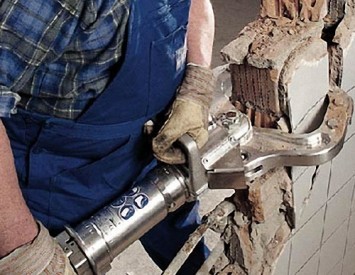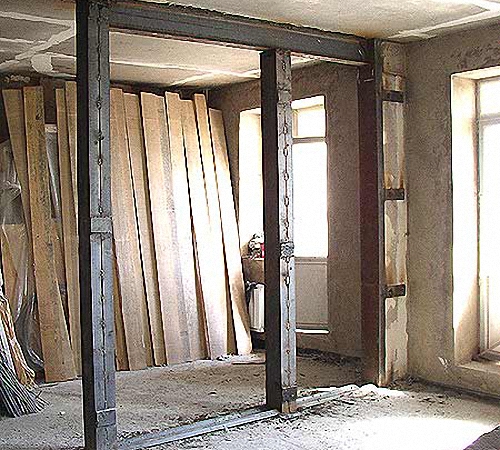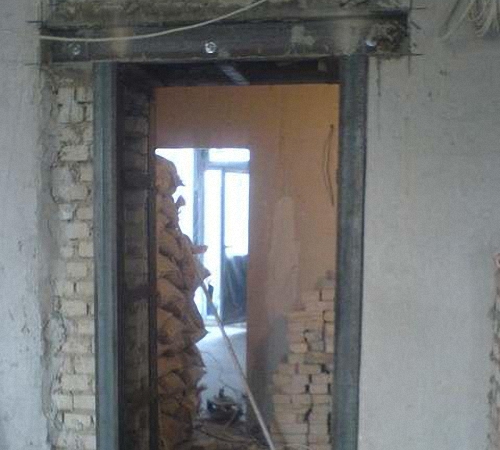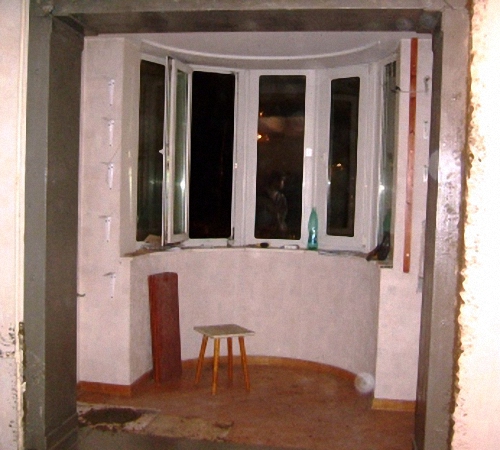To optimize the planning of the apartment, changes in the functionality of some rooms or combining two premises into one, you can not do without such work as the organization of new doorways.
Content
Most walls in panel houses are supporting and are not subject to demolition. But with the right approach, you can make an opening in the bearing wall in any place. It is only necessary to take into account all the characteristics of the wall and fulfill all the rules and norms of cutting the opening. The procedure for manufacturing a new opening can be divided into three stages: punching the opening itself, its decoration and decor.
Project project and its coordination
In multi -storey buildings, almost all walls are supporting. Dismantling them without the presence of an appropriate permission is illegal and can have consequences. Before proceeding with the manufacture of the opening, it is necessary to obtain appropriate permits in the organizations responsible for this. This is necessary not only for personal calm, but also in order to get all the necessary information about the type of wall and its features in order to break and strengthen the opening correctly.
A properly strengthened opening in the load -bearing wall can be installed in any place with some exceptions: the openings cannot be done at the joints of the bearing stoves of the beams, ceilings, the integrity of the columns and poles cannot be violated. Therefore, the organization of the opening should begin only if there is a premises plan on the hands.
How to break through the opening
When all approvals have been completed and there is a ready -made project with permission, you can start work. Their algorithm looks like this:
- Marking the wall for the future opening. Be sure to note the place in which the jumper will be placed. A jumper is the strengthening structure that will support the stove after cutting holes in it. The jumper consists of a fastenced channel fastened to each other, the most optimal amount of them is two. Devices of the opening in a load -bearing without this part are dangerous to the consequences for the entire building.
- When all the markings are placed, through the holes are drilled in the corners of the formed rectangle. The result is working points on the other side of the wall.
- If the work is carried out in a brick wall, then it is necessary to check whether the jumper will support all its elements. To do this, it is necessary to remove the part of the finish at those points where a channel will be installed according to the plan and fit the marking under the brickwork horizontal.
- A niche breaks through a chisel and a hammer into which a jumper is then inserted.
- Test holes for bolts are made with a drill or perforator.
- The formed niche from one edge is filled with a solution, and a channel is inserted from the other. On the back of the wall, the second channel is installed in the same way. The space between these two structures and the wall is filled with a solution. With concrete, only space for tightening fasteners of the jumper is not filled with concrete.
- Channel are pulled together with each other with the help of bolts. They are passed through the left holes, put on washers and nuts, twisted. It is best to use channel with a diameter of 20 mm, the step between them is 40 cm.
- Further work is carried out only after the solution is completely dried.
- Cutting of openings in the load -bearing walls is carried out sequentially so as not to violate the integrity of the entire wall. The work is carried out gradually and small areas. The holes are drilled along the entire marked area through each 2-3 cm, the diameter of the holes is 10-12 mm. There should be so many holes that 10-12 squares can be drawn between them.
- Diamond with a sharp or circle with diamond spraying for a grinder to cut the entire body of the opening according to the obtained holes. Dust during these work can be removed using a construction vacuum cleaner or water shutter.
- The total area of \u200b\u200bthe opening is divided into 10-12 squares, which are then removed. The opening is ready, it remains only to strengthen and decorate it.
Advice: If it is not planned to repair the floor in the room in which a new doorway is organized, then it is recommended to be covered with boards.
Strengthening the opening in the bearing wall
Before decorating a new opening, it must be strengthened in order to avoid the formation of cracks and wall deformation. The most common methods of strengthening:
- one -row -row - ordinary reinforcement with a channel, suitable for concrete and brick walls;
- corner - openings are edged with a corner;
- box, two -row with a screed with a hairpin - combines both a single and corner method of strengthening, the most complex and capital version, which is suitable for complex structures and bearing walls.
One -row strengthening has already been described above. It is preliminary and is an organization of a design of two channels, which are pulled out by bolts and strengthened by concrete. This design has a drawback that requires further decor - the channel protrudes from the wall to the width of their shelves and can ruin the appearance of the opening and room.
Corner strengthening is most often used in panel houses. In this case, the opening is strengthened with two frames from the corners, which are installed on both sides of the wall and tied together by steel plates on all sides of the door hole. Additionally, the design can be strengthened by anchor studs or reinforcement, which is attached to chemical anchors.
The size of the corners is selected based on the floor on which the work is carried out, the thickness of the slab and the total number of storeys of the building. The minimum size of this part is 63x5 mm, the maximum is 140x90x 12 mm. A very reliable method of strengthening, since after the installation of the structure, you can weld its seams between the wall and the steel frame.
The box, two -row strengthening is the most capital type of skin of the opening. It is relevant for dilapidated buildings in which the metal structure in the opening should strengthen concrete or brickwork, and not contribute to its destruction. To do this, all seams and gaps between the structure and the wall are filled with self -expanding solution. In the installation of this design, both corners and channels are used, which are located along the entire length of the opening.
Exterior decoration of the doorway
After all the work is completed, the doorway must be finished. To do this, you can use wood, plastic, drywall, decorative stone or plaster mixtures. The latter option is most attractive to its durability and environmental purity. Due to the lack of joints and edges, the finished slope will look most presentable. Another plus of plaster - the solution will fill all the cracks and voids and additionally strengthen the entire structure. The process of plaster door slopes looks like this:
- First of all, it is necessary to once again verify the reliability of the entire structure, and then proceed to the manufacture of the solution. The solution is prepared in a ratio of 1 to 3 - per 1 shovel of cement 3 shovels of sand.
- For this type of work, a template is used, which can be made from any durable sheet material. If you do not plan to install the door in the opening, then the corners should be protected using corner profiles. They are installed on both sides of the opening, and the space between them is filled with the solution, immediately removing all its excess and leveling the surface.
- After the solution dries, the doorway is painted with an acrylic -based paint. Advice: For plaster the upper part of the opening, a little alabaster can be added to the solution, it will accelerate the solidification process and the layers will not disappear.
- For deep doorways, you can use the finish with drywall. The plus of this type of finish is also that you can easily give the opening any shape.
The finish with drywall is very simple:
- Strips are cut out of the large sheet, the size of which corresponds to the size of the doorway.
- The surface of the opening is processed with alabastr or cement until smooth to fill all the voids under the slope.
- Gypsum cardboard is glued to the surface with glue. You can fix the sheets on a special L-shaped profile.
- The opening is covered with decorative plaster.
- You can use no drywall, but plastic panels or decorative stone. But the specialists recognize the cement screed, which has already been described above. The doorway is subjected to many mechanical influences that drywall or plastic panels may not withstand. In case of violation of their integrity, a replacement of the entire slope structure will be necessary. The cement screed can be easily repaired and brought into the original appearance.
Doorway decor
If the doorways in the load -bearing walls are created open, that is, without the subsequent installation of doors in them, then this gives a wide scope of fantasy in the future decor of the hole. In order to organically enter a new opening into the entire room, you can use the tips below.
- Design of the opening arch. This design option is one of the most popular. It helps to smooth out the sharp corners of the doorway, remove the unnecessary doors, and take the space that is released behind them with a shelf or picture. There are two main options for organizing the arch. The first is ideal for a narrow opening. For its implementation at the top of the opening, a thin design is installed - a frame, which is the basis for the profile. The frame is sheathed with plywood or drywall. The second option is suitable for wide openings, it helps to create a design of an intricate shape, since in a larger area you can create a frame of any configurations. Imitations of the P-shaped columns are attached to the side areas, this gives a special style and sophistication. The opening can be painted or plastered under a stone or marble, decorated with stucco molding or molding. Another interesting solution for a wide opening is the installation of shelves in it. When installing the frame, a place is left for the equipment of built -in shelves on the lateral part of the opening. The arch of the arch can be made asymmetric or symmetrical, of any radius.
- Design with mosaics or stained glass windows. Open areas of the opening are decorated with stained glass windows or mosaic tiles. They are sold in any store of goods for repair and building materials. Sheets of such a decor are glued simply: glue is applied to small sections of the wall, on which small sections of jewelry are immediately attached, you need to move down from top to bottom.
- Regulations and half -columns. This type of decor looks luxurious, but is suitable only for openings in rooms with high ceilings - from 2.5 m. The columns are available in the form of hollow structures that consist of a body, base and capitals. They are simply cut and mounted. Powerfuls also cover pipes and risers in a cramped room to improve the interior.
- Molding. These products are available in a variety of configurations and can be very ornate. Molding is attached to glue, and then covered with paint of any color.
- Design with curtains. Curtains can be purchased already finished or made independently. The original design solution is curtains consisting of beads strung on threads and decorative elements of any shape. To make such a decor, you only need to think over colors, purchase materials and strengthen the cornice above the doorway, on which the product will then be fixed. Specialists in human psychology conducted a number of studies, which showed that curtains from hanging threads have a beneficial effect on the mood, give positive emotions and create internal comfort.















